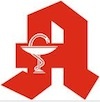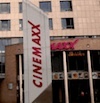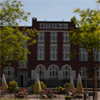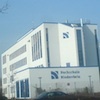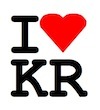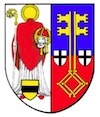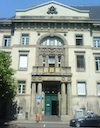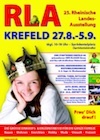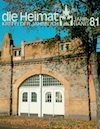Krefeld figures, data and facts

Coat-of-arms and colour
The coat-of-arms depicts the Krefeld town patron Dionysius and the key of the Uerdinger coat-of-arms. The shields remind of Krefeld's former affiliation to the earldom Moers and the state authority of the elector from Cologne and Uerdingen. Krefeld's colours are black-gold.
Population figures
1855: ca. 45.200; 1900: ca. 108.000; 1957: ca. 200 000; 1997: ca. 243.000; 2009: ca. 235.000
Data
Location: 51019'57" northern degree latitude, 6033'48" eastern longitude.
Town surface: 13 755 ha.
Expansion: North/South 12 km, East/West 13,1 km
Rhine front: 6,698 km (current kilometre 760,4 to 767,1). Rhine width: 320-400 m.
Heights: Town centre 39 m, Marketplace Uerdingen 31 m, Hülser Hill 63 m, Inrather Hill 87 m.
Highest viewing point: Viewing tower Hülser Hill 107 m; highest tower: Johannes-Church 79,8 m; highest apartment building: high-rise building Bleichpfad 67,3 m, 23 floors.
History
69 first mention of the village Gellep by Tacitus. Roman marching camp Gelduba was replaced by Kastell later. Expansive Franconian burial grounds. 1226 Krefeld is affiliated with the earldom Moers. 1373 awarding of town charter by Emperor Karl IV. 1600 Krefeld becomes Oranian. Oranians tolerate immigration of Mennonites, who introduced the silk trade. First town expansion. After Prussian occupancy in 1702, silk goods production is taken up again around 1720.
The economic growth required four town expansions in the 18th-century.
1819 town expansion with rectangle of the four ramparts.
The incorporations 1901/07 in the east built the connection to the Rhine. 1905 start of Rhine harbour operation.
1929 union with Uerdingen. Through further incorporations the town area is extended from 4 751ha to 13 755ha.
1936 completion of Rhine bridge. In the 2nd World War around 1/3 of all residential flats were destroyed. a
1975 Hüls incorporated to Krefeld
1983 celebration '300 years Germans in America', after thirteen families emigrated to America in 1683 and founded there the village Germantown.
Agriculture
About half of Krefeld's town district is being used for agriculture. Due to its location Krefeld is the agricultural centre. Around 30 over-regional agricultural institutions have their headquarters in Krefeld.
Cultural life
Town theatre - community theatre with Mönchengladbach (opera, operetta, ballet, play), symphony concerts (Niederrheinische Sinfoniker)
KRESCH - children and youth theatre centre of the town Krefeld (own productions and guest performances; theatre educational activities)
Kaiser Wilhelm Museum (old epoch, focus 20th-century)
Museum Haus Lange and Haus Esters (Changing exhibitions of contemporary avant-garde, Mies-van-der-Rohe-scholarship)
Museum Burg Linn (castle, hunting castle, Lower Rhine museum, Albert-Steeger-scholarship)
German Textile Museum (textiles from European cultures and from outside of Europe)
City library (inventory 233.598 media, ea book bus with stops in all districts, events of the Dante-days in Krefeld)
Adult education centre
Krefeld zoo
City archive (written sources regarding city history, newspaper and photo collections)
Villa Merländer (national socialistic documentation and meeting centre),
Music school (appr. 2.129 pupils, a.o. instrumental-, single and group lessons, singing and play groups, choir, orchestra and chamber music)
Kulturamt/cultural office (serenades in the knight hall of the castle Linn, unique concert of changes in all city districts, regular large events with a changing theme)
Factory Heeder (public meeting place, music, dance, cabaret shows, theatre guest performances a.o.)
Cultural factory (alternative to the city culture in private sponsorship)
House Greiffenhorst (Linn) and "Klöske" (Uerdingen) as cultural event ventures.
Sport facilities
Great indoor sport arena Glockenspitz (playing area 60 x 40 m, 3 200 seats for spectators)
6 tripple indoor sports halls
13 double indoor sports halls
42 single indoor sports halls
18 gymnastic rooms
8 sport shooting facilities incl. archery
1 combined indoor swimming/leisure pool
4 indoor pools; 3 outdoor pools
138 tennis courts
16 indoor tennis- and squash halls
26 sport grounds (53 playing fields, 14 small playing fields)
5 boat houses
2 indoor ice halls
2 field hockey grounds
2 golf course (18 holes)
Recreation park, lake Elfrather (regatta course, swimming lake, sport fishing, sail-surf location, 1 leisure sport ground)
1 horse race course with a golf course (9 holes)
1 golf course (6 holes) with driving range
1 yacht harbour
Building monuments
The list of monuments of the city of Krefeld consists appr. 709 objects, among these are:  St. Matthias, Hohenbudberg (12./19th century.),
St. Matthias, Hohenbudberg (12./19th century.),  St. Clemens, Fischeln (12./19th century).
St. Clemens, Fischeln (12./19th century).  Kurkölnische Landesburg (12./18th century),
Kurkölnische Landesburg (12./18th century),  Haus Rath (13./18th century) manor house
Haus Rath (13./18th century) manor house Neuenhofen (13./19th century),
Neuenhofen (13./19th century),  St. Peter, Uerdingen, (14./19th century),
St. Peter, Uerdingen, (14./19th century),  Floh'sche Haus, Friedrichstraße (1766),
Floh'sche Haus, Friedrichstraße (1766),  Rathaus/town hall Krefeld (former city castle von der Leyen, 1794),
Rathaus/town hall Krefeld (former city castle von der Leyen, 1794),  Herrensitz/manor house Sollbrüggen (12./19th century),
Herrensitz/manor house Sollbrüggen (12./19th century),  Herbertzhäuser, Uerdinger Markt (1832),
Herbertzhäuser, Uerdinger Markt (1832),  Altes Rathaus/old town hall Uerdingen (1725),
Altes Rathaus/old town hall Uerdingen (1725),  Convent church of the former cloister St. Cäcilia Hüls (15./18th century).
Convent church of the former cloister St. Cäcilia Hüls (15./18th century).
Town-twinning
Venlo (NL), ca. 62.500 citizens, since 1964
Leicester (GB), ca. 275.000 citizens, since 1969
Dünkirchen (F), ca. 74.000 citizens, since 1974
Leiden (NL), ca. 104.000 citizens, since 1974
Charlotte (USA), ca. 400.000 citizens, since 1986
Rural district Oder-Spree (D), ca. 192.000 citizens, since 1990
Uljanowsk (R U S), ca. 650.000 citizens, since 1993

 Deutsch
Deutsch Nederlands
Nederlands Dansk
Dansk Österreichisch
Österreichisch Po Polsku
Po Polsku



